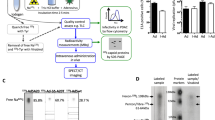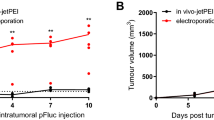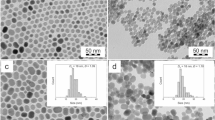Abstract
Noninvasive in vivo monitoring of gene delivery would provide a critically important information regarding the spatial distribution, local concentration, kinetics of removal and/or biodegradation of the expression vector. We developed a novel approach to noninvasive gene delivery imaging using heterobifunctional peptide-based chelates (PBC) bearing double-stranded DNA-binding groups and a technetium-binding amino acid motif. One of such chelates: Gly-Cys(Acm)-Gly-Cys(Acm)-Gly-Lys4-Lys-(N-ε-[4-(psoralen-8-yloxy)]butyrate)-NH2 has been characterized and labeled with reduced 99mtc pertechnetate (oxotechnetate). the psoralen moiety (a dna binding group of pbc) allowed linking to double-stranded dna upon short-term irradiation with the near uv range light (>320 nm). Approximately 30–40% of added 99mTc-labeled PBC was nonextractable and co-eluted with a model pCMV-GFP vector during the gel-permeation chromatography. Nuclear imaging of ‘naked’ DNA and DNA complexes with lipid-based transfection reagents (‘lipoplexes’) has been performed after systemic or local administration of 99mTc-PBC-labeled DNA in mice. Imaging results were corroborated with the biodistribution using 99mTc-PBC and 32P-labeled DNA and lipoplexes. A markedly different biodistribution of 99mTc PBC-labeled DNA and lipoplexes was observed with the latter being rapidly trapped in the liver, spleen and lung. 99mTc PBC-DNA was used as an imaging tracer during in vivo transfection of B16 melanoma by local injection of ‘naked’ 99mTc PBC-DNA and corresponding lipoplexes. As demonstrated by nuclear imaging, 99mTc PBC-DNA lipoplexes showed a slower elimination from the site of injection than 99mTc PBC-DNA alone. This result correlated with a higher expression of marker mRNA and green fluorescent protein as determined using RT-PCR and immunohistochemistry, respectively.
This is a preview of subscription content, access via your institution
Access options
Subscribe to this journal
Receive 12 print issues and online access
$259.00 per year
only $21.58 per issue
Buy this article
- Purchase on Springer Link
- Instant access to full article PDF
Prices may be subject to local taxes which are calculated during checkout








Similar content being viewed by others
References
Blasberg RG, Tjuvajev JG . Herpes simplex virus thymidine kinase as a marker/reporter gene for PET imaging of gene therapy Quart J Nucl Med 1999 43: 163–169
Bogdanov A Jr, Weissleder R . The development of in vivo imaging systems to study gene expression Trends Biotechnol 1998 16: 5–10
Moats RA, Fraser SE, Meade TJ . A ‘smart’ magnetic resonance imaging agent that reports on specific enzymatic activity Angew Chem IntEd 1997 36: 726–731
de Marco G et al. MR imaging of gene delivery to the central nervous system with an artificial vector Radiology 1998 208: 65–71
Hawrylak N et al. Nuclear magnetic resonance (NMR) imaging of iron oxide-labeled neural transplants Exp Neurol 1993 121: 181–192
Schellingerhout D et al. Mapping the in vivo distribution of Herpes simplex virions Hum Gene Ther 1998 9: 1543–1549
Zinn KR et al. Imaging and tissue biodistribution of 99mTc-labeled adenovirus knob (serotype 5) Gene Therapy 1998 5: 798–808
Simonova M et al. Targeting of green fluorescent protein expression to the cell surface Biochem Biophys Res Commun 1999 262: 638–642
Gia O et al. Sequence specificity of psoralen photobinding to DNA: a quantitative approach Biochemistry 1992 31: 11818–11822
Kanne D et al. Psoralen-deoxyribonucleic acid photoreaction. Characterization of the monoaddition products from 8-methoxypsoralen and 4,5′8-trimethylpsoralen Biochemistry 1982 21: 861–871
Moore A et al. Novel gliosarcoma cell line expressing green fluorescent protein: a model for quantitative assessment of angiogenesis Microvasc Res 1998 56: 145–153
Bogdanov A Jr, Kayne L, Weissleder R . Graft copolymers as carriers for systemic delivery of expression vectors Proc Intl Symp Control Rel Bioact Mater 1998 25: 214–215
Felgner PL et al. Nomenclature for synthetic gene delivery systems (editorial) Hum Gene Ther 1997 8: 511–512
Felgner PL . Prospects for synthetic self-assembling systems in gene delivery (interview) J Gene Med 1999 1: 290–292
Felgner PL . DNA vaccines Curr Biol 1998 8: R551–R553
Ghosh SS et al. Liver-directed gene therapy: promises, problems and prospects at the turn of the century J Hepatol 2000 32: 238–252
Sandhu JS, Keating A, Hozumi N . Human gene therapy Crit Rev Biotechnol 1997 17: 307–326
Wolff JA . Naked DNA transport and expression in mammalian cells Neuromusc Dis 1997 7: 314–318
Felgner PL . Nonviral strategies for gene therapy Sci Am 1997 276: 102–106
Mahato RI . Non-viral peptide-based approaches to gene delivery J Drug Target 1999 7: 249–268
Zelphati O et al. Gene chemistry: functionally and conformationally intact fluorescent plasmid DNA Hum Gene Ther 1999 10: 15–24
Plank C et al. Activation of the complement system by synthetic DNA complexes: a potential barrier for intravenous gene delivery Hum Gene Ther 1996 7: 1437–1446
Zelphati O, Szoka FC Jr . Mechanism of oligonucleotide release from cationic liposomes Proc Natl Acad Sci USA 1996 93: 11493–11498
Xu Y, Szoka FC Jr . Mechanism of DNA release from cationic liposome/DNA complexes used in cell transfection Biochemistry 1996 35: 5616–5623
Sixou S et al. Intracellular oligonucleotide hybridization detected by fluorescence resonance energy transfer (FRET) Nucleic Acids Res 1994 22: 662–668
Chin DJ et al. Rapid nuclear accumulation of injected oligodeoxyribonucleotides New Biol 1990 2: 1091–1100
Zelphati O et al. PNA-dependent gene chemistry: stable coupling of peptides and oligonucleotides to plasmid DNA Biotechniques 2000 28: 304–310, 312–314, 316
Neves C et al. Novel method for covalent fluorescent labeling of plasmid DNA that maintains structural integrity of the plasmid Bioconj Chem 2000 11: 51–55
Meyer KB et al. Intratracheal gene delivery to the mouse airway: characterization of plasmid DNA expression and pharmacokinetics Gene Therapy 1995 2: 450–460
Levy MY et al. Characterization of plasmid DNA transfer into mouse skeletal muscle: evaluation of uptake mechanism, expression and secretion of gene products into blood Gene Therapy 1996 3: 201–211
Mardirossian G et al. In vivo hybridization of technetium-99m-labeled peptide nucleic acid (PNA) J Nucl Med 1997 38: 907–913
Winnard P Jr et al. Preparation and use of NHS-MAG3 for technetium-99m labeling of DNA Nucl Med Biol 1997 24: 425–432
Herman JR et al. In situ gene therapy for adenocarcinoma of the prostate: a phase I clinical trial Hum Gene Ther 1999 10: 1239–1249
O'Malley BW Jr, Li D . Combination gene therapy for salivary gland cancer Ann New York Acad Sci 1998 842: 163–170
Wollenberg B et al. Gene therapy – phase I trial for primary untreated head and neck squamous cell cancer (HNSCC) UICC stage II–IV with a single intratumoral injection of hIL-2 plasmids formulated in DOTMA/Chol Hum Gene Ther 1999 10: 141–147
Li D et al. Combination surgery and nonviral interleukin 2 gene therapy for head and neck cancer Clin Cancer Res 1999 5: 1551–1556
Schuler M et al. A phase I study of adenovirus-mediated wild-type p53 gene transfer in patients with advanced non-small cell lung cancer Hum Gene Ther 1998 9: 2075–2082
Lang FF et al. Adenovirus-mediated p53 gene therapy for human gliomas Neurosurgery 1999 45: 1093–1104
Bogdanov A Jr, Simonova M, Weissleder R . Design of metal-binding green fluorescent protein variants Biochim Biophys Acta 1998 1397: 56–64
Acknowledgements
Authors are grateful to Drs Maria Simonova and James Basilion for advice on 32P-labeling. Acknowledged is also the participation of Dr Lee Kayne in the early feasibility experiments. The work was supported in part by NIH: 5RO1 NS35258–03 (RW); 5RO1 CA74424–01 (AB) and 1R21 DK55713–01 (CT).
Author information
Authors and Affiliations
Rights and permissions
About this article
Cite this article
Bogdanov, A., Tung, CH., Bredow, S. et al. DNA binding chelates for nonviral gene delivery imaging. Gene Ther 8, 515–522 (2001). https://doi.org/10.1038/sj.gt.3301410
Received:
Accepted:
Published:
Issue Date:
DOI: https://doi.org/10.1038/sj.gt.3301410
Keywords
This article is cited by
-
Methods for MAG3 conjugation and 99mTc radiolabeling of biomolecules
Nature Protocols (2006)
-
Gene Therapy Progress and Prospects: Noninvasive imaging of gene therapy in living subjects
Gene Therapy (2004)
-
Gene transfer vector biodistribution: pivotal safety studies in clinical gene therapy development
Gene Therapy (2004)



